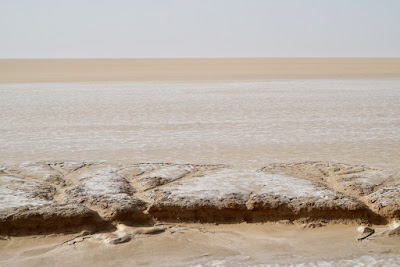Fifty Words for Sand
In the life of every traveller there are, by default, many days spent travelling. One gets to know the local buses, trains and louages intimately - and the road to uncharted territories stretches out temptingly.
Temptingly, and in the case of Tunisia, straight as an arrow. With the exception of the mountanous regions, draw a line on the map from A to B and that’s how the road will go. Indeed, I had no reason to worry about not getting the front seat in the louage from Tunis to Tozeur: even I couldn’t get car sick on roads like these. I don’t think we hit a single curve the whole way
We did hit several speed bumps though. Every time there’s more than one hut and a goat by the roadside, there’ll be a speed bump to slow drivers down. And for good reason.
I’ve discovered the most useless school in Tunisia - the driving school. Either absolutely nobody attends them or then the schools are so bad, it’s not worth going. The local driving culture here would be funny if it weren’t dangerous. In fact there was a horrific bus accident here only yesterday, in which over 20 people lost their lives. Sad, but hardly surprising. The drivers here are an accident waiting to happen.
The only saving grace is that the traffic is quite light, since clearly most people can’t afford a car. Also Tunisia is not the most populous nation - some 12 million inhabitants in a country half the size of Finland. Much of the country is, let’s face it, rather uninhabitable: sand and heat make for an inhospitable environment for all but the hardiest of nomad camel herders.
In a country of bad drivers, louage drivers seem to be in a class of their own. Speed limits are merely suggestions to be sneered at. I kid you not that our louage driver on that first trip was hitting 140km/h also through residential areas with a speed limit of 50km/h. All the while either talking on the phone, texting or reading texts.
Apart from speedbumps, the only thing that efficiently slows down drivers are police check points. You know you’re approaching a checkpoint, not a speedbump, because not only does your driver slow down, he also buckles his seatbelt. As soon as the checkpoint has been passerd the foot hits the gas pedal and the seatbelt comes back off. I have also not seen one single motorcyclist wearing a helmet the whole time I’ve been here.
Traffic signs are merely minor inconveniences that need not be taken too seriously.
On the long roads through the desert regions, one occasionally runs into roaming camels. I expect they belong to someone, but the ownership is less obvious than in the case of sheep, who graze nomadically and are always accompanied by their shepherd. Some larger flocks have several shepherds and sheep dogs, but the most common setup seems to 10-20 sheep grazing by the dusty roadside with one shepherd gazing on.
Talking of dusty... well sandy would be the more appropriate word.
The cliché is that Inuits have over 50 words for snow. If that were true, by the same logic, the Berbers should have over 50 words for sand.
Frankly, it’s not the most beautiful landscape to travel through. Mostly outside the Sahara proper the sand is unattractive: gritty and stony, blasted rock, granular sand and tough and hardy round spiky bushes of the kind that when they finally do give up the good fight they end up having bit parts in Hollywood movies as the dry rolling bushes that blow across the desert floor just before the good guy and the bad guy have their final shoot-out.
Then in central Tunisia you have the salt deserts and salt lakes. An elevated road cuts straight as an arrow through the flat arid stretch of the biggest salt desert. In the middle of this stretch there is a salt factory. You work with what you are given.
Then on the fringes of the Sahara itself, sand starts to pile up into dunes, which, being in a constantly moving state, threaten to overtake the road. Ingenious fences made from palm leaves are built on top of the dunes to hold them in place.
On a windy day the sand is blown across the surface in small sand storms. In even these minor affairs, the sand stings uncomfortably at any exposed skin, visibility is very low and the text on milestones is sand blasted into oblivion on the side of the predominant wind.
It’s hard for me to wax lyrical about sand. Sand is sand is sand - much as, to me, snow is snow is snow: best avoided.
But admittedly there are moments when the light catches the endless landscape of sand in just the right way, which morph those tiny granules of rock into something quite beautiful.



















Comments